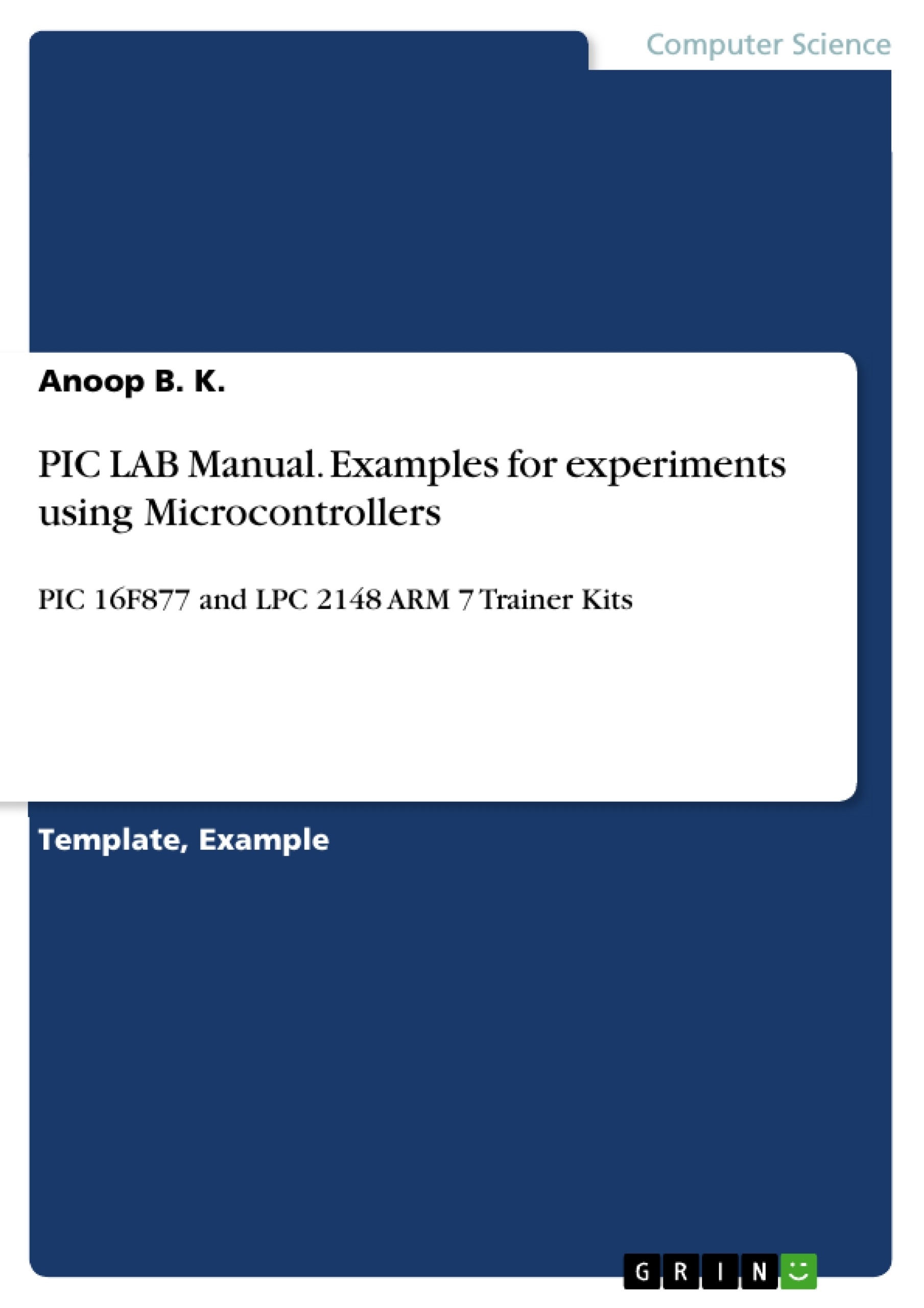This document contains examples for the implementation of a range of experiments on the PIC 16F877 Microcontroller and the LPC 2148 ARM 7 Processor.
Table of Contents
- PIC 16F877 MICROCONTROLLER TRAINER KIT.
- FAMILIARIZATION OF KIT
- Features
- Hardware Specification.....
- 12C Based Devices:
- MPLAB IDE.
- Windows Serial Downloader.......
- Windows Win X Talk Serial Output Window....
- BUZZER CONTROL.
- RELAY CONTROL.
- WRITING TO LED ARRAY
- READING DIP SWITCH
- READING MATRIX KEYPAD
- WRITING TO LCD DISPLAY.
- SERIAL TRANSMIT& RECEIVE
- RTC (REAL TIME CLOCK)..\li>
- 8 BIT DAC.
- TEMPERATURE SENSOR
- SERIAL EEPROM
- LPC 2148 ARM PROCESSOR TRAINER KIT.
- FAMILIARIZATION OF TRAINER KIT
- Features
- Applications........
- On Board Peripherals.
- IAR EMBEDDED WORKBENCH..\li>
- Running IAR Embedded Workbench:..\li>
- Running Launch LPC 210x-IS down loader:.\li>
- Running Windows Win X Talk Serial Output Window:\li>
- BUZZER CONTROL
- RELAY CONTROL.
- WRITING TO LED ARRAY
- READING DIP SWITCH
- READING MATRIX KEYPAD
- 8 BIT A/D CONVERTOR..\li>
- TEMPERATURE SENSOR
- 8 BIT D/A CONVERTOR.
- PIC 16F877 MICROCONTROLLER TRAINER KIT
- EXPERIMENT 1.
- FAMILIARIZATION OF KIT
- Aim:
- Introduction
- CPUs Supported
- Features
- On-Chip Features:
Objectives and Key Themes
The primary objective of this text is to provide a comprehensive guide to working with the PIC 16F877 and LPC 2148 microcontroller trainer kits. The text aims to familiarize users with the kits' features, hardware specifications, and programming tools, enabling them to conduct experiments and develop applications.
- Microcontroller Kit Familiarization
- Hardware and Software Integration
- Peripheral Device Control and Programming
- Real-time Clock and Data Storage
- Analog-to-Digital and Digital-to-Analog Conversion
Chapter Summaries
The text begins by introducing the PIC 16F877 microcontroller trainer kit, detailing its features, hardware specifications, and supported microcontrollers. It then delves into the familiarization process, outlining the use of MPLAB IDE and serial communication tools. Subsequent sections cover a range of programming examples, showcasing the control of peripherals such as LEDs, relays, and LCD displays. The text also explores data storage and retrieval using serial EEPROMs and real-time clocks. The final section focuses on the LPC 2148 ARM processor trainer kit, outlining its features, applications, and programming environment.
Keywords
This text focuses on microcontroller trainer kits, specifically the PIC 16F877 and LPC 2148. It explores key concepts such as microcontroller programming, peripheral device control, data storage and retrieval, analog-to-digital conversion, digital-to-analog conversion, and the use of programming tools like MPLAB IDE and IAR Embedded Workbench. The text also touches upon specific hardware components like serial EEPROMs, real-time clocks, LCD displays, and LEDs.
- Quote paper
- Anoop B. K. (Author), 2015, PIC LAB Manual. Examples for experiments using Microcontrollers, Munich, GRIN Verlag, https://www.grin.com/document/313312




